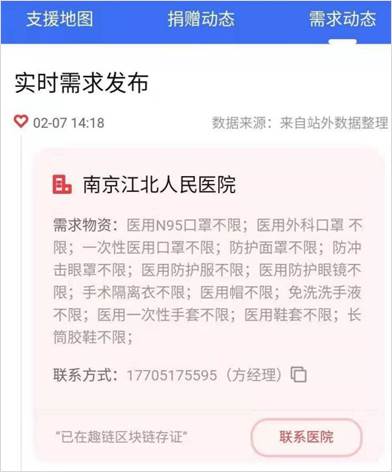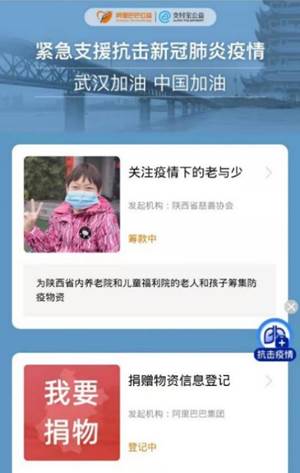People's Network: Blockchain technology helps make charity more transparent
Source: People's Daily Online-Public Opinion Channel
Author: HU Rui Ying, Zhang Shanshan
Editor's note: Since the outbreak of the new coronavirus pneumonia, people across the country have been united, and the current epidemic prevention and control has entered a critical period. In the process of epidemic prevention and control, various chaotic phenomena are mixed to stir up public opinion. The People's Daily Public Opinion Data Center / People's Online will combine its own technical and content advantages to give "people's interpretation" and "people's plan", and launch a plan for "epidemic enlightenment." Records ", which help to solve the financing of small, medium and micro enterprises from fintech, blockchain technology to solve the problem of public welfare trust, integrate media centers to improve the effectiveness of public opinion guidance, how to release information in major epidemics, and the application of big data in epidemic prevention and control How to evaluate and prevent potential public opinion risks after a major epidemic occurs, how to deal with rumors in major epidemics, the challenges of live news in major epidemics, and the monitoring and application of online social sentiment, to readers.
- Ethereum 2.0 testnet is about to launch, can host 100,000 validators
- Viral "whistleblower" plan: a regional grassroots linkage early warning network based on blockchain
- Popular science | How to design Optimistic Rollup to achieve sustainable expansion and decentralization?
This epidemic is a big test of our country's governance system and capabilities. The big test should be thoughtful before we can promote the progress of social governance.
After the outbreak of the new coronavirus pneumonia epidemic, it quickly showed a raging trend. The frontline medical supplies of Wuhan under the "capped city" ran out, and people across the country sent medical supplies and raised donations to help Wuhan. At the same time, Hubei Provincial Red Cross and Wuhan Red Cross were questioned about unfair distribution of donated materials, a large backlog of donated items, and inefficient distribution. News from Wuhan Red Cross Security Blocked CCTV reporters was exposed by the media. Institutions are on the cusp of public opinion.
The reason why the Red Cross Society of Hubei Province and the Red Cross Society of Wuhan City were questioned is that the information, such as the use of materials and charitable funds, was released in a timely, non-public, and opaque manner. This is exactly the pain and difficulty facing the development of public welfare and charity. If these pain points and difficulties can be solved with the help of blockchain technology. Blockchain technology can easily solve a series of problems such as unclear definition of institutions, financial opacity, and low management efficiency, thereby promoting the development of public welfare behaviors into fragmentation, miniaturization, and normalization, allowing donors to "every package Instant noodles can be publicized ", which further enhances the social influence of charity.
Blockchain technology solves the problem of trust in charity
There are several problems in the field of traditional public welfare charity in terms of fund management and information recording: the information review of the recipients and donation projects is not strict enough to make true and effective identification; the process of collecting and using money is difficult to be transparent and open; and public welfare funds First enter the institutional account, and then the agency performs the operation and processing. The multi-level operation is cumbersome, and the labor and time costs are high.
In contrast, blockchain technology has the advantages of decentralization, openness and transparency, information traceability, and automatic execution through smart contracts. These advantages correspond to the problems that have been criticized in traditional public welfare charity projects, which can fundamentally Solve the public trust problem.
First, decentralization. The blockchain can distribute the relevant information of charitable public welfare projects on each node of the Internet, and it is extremely difficult to tamper with the data of all nodes on the entire network at the same time. This prevents an organization or individual from controlling a charity public welfare project for their own benefits.
Second, openness and transparency. All information on the blockchain is open to the entire network. Regulators and eligible organizations can query and trace each transaction through observation nodes. In this way, you can know who the corresponding recipients of each donation are, how they are used, how many times have been issued, how effective the rescue is, etc. You can point-to-point inquire and trace the relevant responsible person.
Again, the information is traceable. The donor is directly linked to the donated project, and the circulation data of each payment is stored and solidified. All parties can check and supervise, and know each donation to ensure the openness and transparency of public welfare projects.
Finally, the use of blockchain smart contracts solves problems such as complex processes and black box operations in traditional charity projects. After setting the relevant conditions and requirements, the smart contract can be executed automatically. For example, we receive a request for help from a poor child, and the system automatically generates a smart contract. The smart contract confirms the authenticity and then provides a rescue plan. The amount of the money, the steps of using the money, and the effect that will be achieved will be reflected in the contract. The entire contract can be operated automatically from receipt to execution, and the implementation is automatically given feedback. The entire process does not require manual intervention and is subject to the supervision of all parties involved. The fully automatic model of smart contracts ensures a smooth landing of the project.
Donate funds to host charity
Due to the exposure of many unknown funds to unknown events, netizens gradually lost confidence in charitable organizations, and some netizens even believed that an organization or individual manipulated charitable projects for their own benefit. Faced with such a problem, donating on the chain can make charity more fair.
Specifically, the platform can introduce funds custody banks and other institutions that meet regulatory requirements to conduct special custody of donated funds. The platform party does not directly contact the donated funds. All donated funds are automatically allocated by the system according to the donation agreement and the entire process is isolated. Therefore, for donors, this method of donation is more convenient and safer than traditional methods of donation, and there is no need to worry about the misappropriation of funds, and there is no need to question the reliability of the recipient organization; Channels can attract more donors to participate, while bypassing regional and policy donation restrictions, and greatly expanding the scope of potential donors.
Information traceability and bookkeeping public welfare on-chain are more transparent
On January 28th, the People's Daily reported that in order to help the people of Wuhan overcome the difficulties, Shandong Shouguang donated 350 tons of fresh vegetables free of charge, and promised to continue to supply high-quality and cheap vegetables in Wuhan for 10-15 days. . Subsequently, the Wuhan Bureau of Commerce stated that 350 tons of vegetables donated by Shouguang for free will be sold at a low price in Wuhan and all the sales proceeds will be donated to the Wuhan Red Cross. Netizens asked one after another: Where did the money go? At noon on January 30, the Wuhan Red Cross issued an emergency statement: The Wuhan Red Cross did not receive a cash donation of 350 tons of Shouguang vegetables. And in its statement, it said that it currently only receives urgently needed medical supplies related to epidemic prevention and control, and that the 350 tons of vegetable funds are destined to detonate public opinion. Looking back, the unknown whereabouts of charitable funds has always been one of the pain points of public welfare and charity. It has continuously stimulated the audience's suspicion of charity, and secondly, it has given the criminals a chance. But if you use the blockchain to trace the source of donations, you can quickly solve such problems.
Specifically, blockchain technology has the characteristics of distributed storage, and naturally has the function of bookkeeping and information tracing. In the field of charitable donations, by using distributed ledgers to track donation information to ensure that each donation is clear and transparent.
As early as 2017, China has tried to trace the material public welfare donation process for blockchain technology. In September, the "Mengshou Angels Finding Journey" public welfare project launched by the Beautiful China Support Education Project was launched on the Jingdong Public Welfare Connected Platform. Through the combination of blockchain technology and the Internet of Things, not only the information on the entire flow of donated materials can be uploaded to the chain, the transparency of the material transfer information can be traced, but also the user experience of online donors has been greatly improved.
In the face of this epidemic, China Xiong'an Group opened a charity donation management traceability platform to improve the transparency and credibility of donation information with the characteristics of blockchain technology. Log on to the charity donation traceability platform and see that among the list of completed donations, the earliest donations were donated by Hangzhou FunChain Technology Co., Ltd. The recipient is the Central Theater General Hospital (Wuchang Park). The donation time is the evening of February 6. 19:39:33, and the logo has been deposited in the Feilo Blockchain. Among the donations to be donated, taking Nanjing Jiangbei People's Hospital as an example, the required materials include medical N95 masks, medical surgical masks, protective masks, and other donation contact information. In each donated and completed project, the platform displays the corresponding block information, block height, unique identification of the certificate, and the time of listing. It also indicates that this demand is currently on the FunChain blockchain. Deposit certificate and provide public donation information inquiry service for everyone.

Charity donation traceability platform
Reduce the cost of information operations and improve the efficiency of charity management
On February 1st, Hubei Province held a press conference on the prevention and control of pneumonia outbreaks of new coronavirus infection. A reporter asked at the press conference: Wuhan Red Cross Society receives a large amount of supplies. Why are some hospitals still facing a shortage of supplies? In this regard, Li Qiang, a member of the party group of the Wuhan Municipal Government, said that there are also some gaps in our work, such as insufficient turnover and timely transfer.
The current epidemic is racing against time. Speed is life. In the face of untimely information sharing, the distributed storage ledger and sharing function of the blockchain can easily solve this problem. Share the information of public welfare charity projects through the blockchain, associate with organizations with Internet fundraising authority on related networks, and connect with precise poverty alleviation information from various government departments and hospitals, so that the entire rescue process can be online. Reduce the operating costs of information systems and reduce the burden of information sharing.

Figure: Some screenshots of Alipay's "Emergency Support to Fight New Crown Pneumonia Outbreak" service platform
Faced with a tense epidemic, Alipay launched the "Emergency Support to Fight New Coronary Pneumonia Epidemic Situation" service platform in the "I want to donate" column. There are already 33 projects, of which 1 project is in fundraising and 1 project is being registered. The rest are projects that have completed fundraising. In the ongoing fundraising project-"Focus on the old and the young in the epidemic" project, we can see that the donation money is updated in real time, and relevant disclosures have also been made to the registration number of public welfare institutions and fundraising schemes.
We will continue to update Blocking; if you have any questions or suggestions, please contact us!
Was this article helpful?
93 out of 132 found this helpful
Related articles
- Research Report | The biggest hidden danger of blockchain security in 2020 is it
- Business Insider predicts that Libra will not be officially released in 2020, and China will release digital currency
- Instead of gaining weight, build a knowledge map of the blockchain in 7 days and 14 hours | Babbitt Industry Welcome Orientation
- Revisiting 2020, Bitcoin wants to say
- Compared with Bitcoin, will Ethereum be more risky in the past six months?
- Hedge funds short Zcash and XRP to hear what they say
- 22 halving coins detonated 2020: ferocious little coins, taking you to heaven and hell






